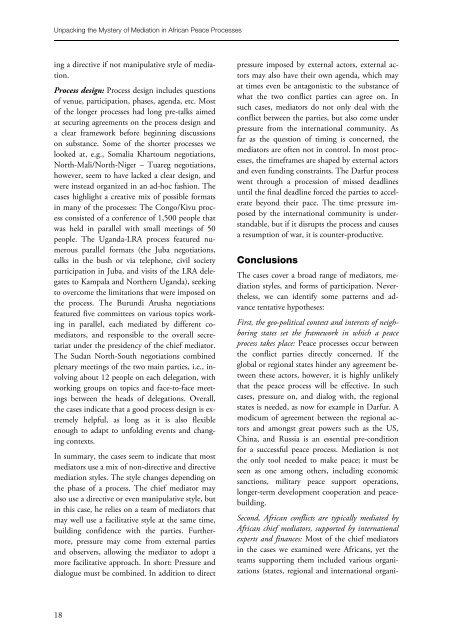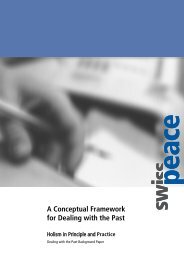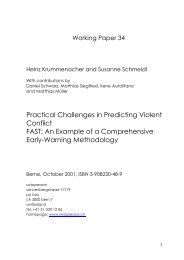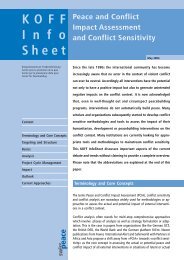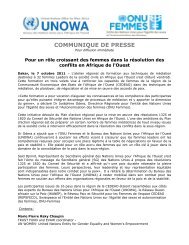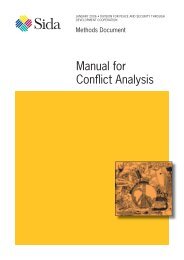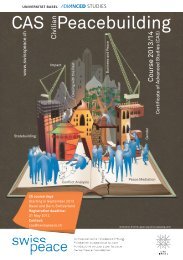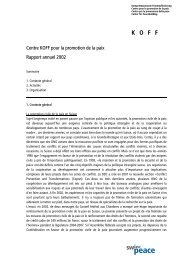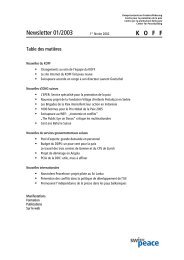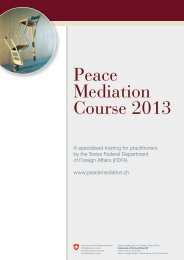Unpacking the Mystery of Mediation in African Peace ... - Swisspeace
Unpacking the Mystery of Mediation in African Peace ... - Swisspeace
Unpacking the Mystery of Mediation in African Peace ... - Swisspeace
You also want an ePaper? Increase the reach of your titles
YUMPU automatically turns print PDFs into web optimized ePapers that Google loves.
<strong>Unpack<strong>in</strong>g</strong> <strong>the</strong> <strong>Mystery</strong> <strong>of</strong> <strong>Mediation</strong> <strong>in</strong> <strong>African</strong> <strong>Peace</strong> Processes<br />
<strong>in</strong>g a directive if not manipulative style <strong>of</strong> mediation.<br />
Process design: Process design <strong>in</strong>cludes questions<br />
<strong>of</strong> venue, participation, phases, agenda, etc. Most<br />
<strong>of</strong> <strong>the</strong> longer processes had long pre-talks aimed<br />
at secur<strong>in</strong>g agreements on <strong>the</strong> process design and<br />
a clear framework before beg<strong>in</strong>n<strong>in</strong>g discussions<br />
on substance. Some <strong>of</strong> <strong>the</strong> shorter processes we<br />
looked at, e.g., Somalia Khartoum negotiations,<br />
North-Mali/North-Niger – Tuareg negotiations,<br />
however, seem to have lacked a clear design, and<br />
were <strong>in</strong>stead organized <strong>in</strong> an ad-hoc fashion. The<br />
cases highlight a creative mix <strong>of</strong> possible formats<br />
<strong>in</strong> many <strong>of</strong> <strong>the</strong> processes: The Congo/Kivu process<br />
consisted <strong>of</strong> a conference <strong>of</strong> 1,500 people that<br />
was held <strong>in</strong> parallel with small meet<strong>in</strong>gs <strong>of</strong> 50<br />
people. The Uganda-LRA process featured numerous<br />
parallel formats (<strong>the</strong> Juba negotiations,<br />
talks <strong>in</strong> <strong>the</strong> bush or via telephone, civil society<br />
participation <strong>in</strong> Juba, and visits <strong>of</strong> <strong>the</strong> LRA delegates<br />
to Kampala and Nor<strong>the</strong>rn Uganda), seek<strong>in</strong>g<br />
to overcome <strong>the</strong> limitations that were imposed on<br />
<strong>the</strong> process. The Burundi Arusha negotiations<br />
featured five committees on various topics work<strong>in</strong>g<br />
<strong>in</strong> parallel, each mediated by different comediators,<br />
and responsible to <strong>the</strong> overall secretariat<br />
under <strong>the</strong> presidency <strong>of</strong> <strong>the</strong> chief mediator.<br />
The Sudan North-South negotiations comb<strong>in</strong>ed<br />
plenary meet<strong>in</strong>gs <strong>of</strong> <strong>the</strong> two ma<strong>in</strong> parties, i.e., <strong>in</strong>volv<strong>in</strong>g<br />
about 12 people on each delegation, with<br />
work<strong>in</strong>g groups on topics and face-to-face meet<strong>in</strong>gs<br />
between <strong>the</strong> heads <strong>of</strong> delegations. Overall,<br />
<strong>the</strong> cases <strong>in</strong>dicate that a good process design is extremely<br />
helpful, as long as it is also flexible<br />
enough to adapt to unfold<strong>in</strong>g events and chang<strong>in</strong>g<br />
contexts.<br />
In summary, <strong>the</strong> cases seem to <strong>in</strong>dicate that most<br />
mediators use a mix <strong>of</strong> non-directive and directive<br />
mediation styles. The style changes depend<strong>in</strong>g on<br />
<strong>the</strong> phase <strong>of</strong> a process. The chief mediator may<br />
also use a directive or even manipulative style, but<br />
<strong>in</strong> this case, he relies on a team <strong>of</strong> mediators that<br />
may well use a facilitative style at <strong>the</strong> same time,<br />
build<strong>in</strong>g confidence with <strong>the</strong> parties. Fur<strong>the</strong>rmore,<br />
pressure may come from external parties<br />
and observers, allow<strong>in</strong>g <strong>the</strong> mediator to adopt a<br />
more facilitative approach. In short: Pressure and<br />
dialogue must be comb<strong>in</strong>ed. In addition to direct<br />
18<br />
pressure imposed by external actors, external actors<br />
may also have <strong>the</strong>ir own agenda, which may<br />
at times even be antagonistic to <strong>the</strong> substance <strong>of</strong><br />
what <strong>the</strong> two conflict parties can agree on. In<br />
such cases, mediators do not only deal with <strong>the</strong><br />
conflict between <strong>the</strong> parties, but also come under<br />
pressure from <strong>the</strong> <strong>in</strong>ternational community. As<br />
far as <strong>the</strong> question <strong>of</strong> tim<strong>in</strong>g is concerned, <strong>the</strong><br />
mediators are <strong>of</strong>ten not <strong>in</strong> control. In most processes,<br />
<strong>the</strong> timeframes are shaped by external actors<br />
and even fund<strong>in</strong>g constra<strong>in</strong>ts. The Darfur process<br />
went through a procession <strong>of</strong> missed deadl<strong>in</strong>es<br />
until <strong>the</strong> f<strong>in</strong>al deadl<strong>in</strong>e forced <strong>the</strong> parties to accelerate<br />
beyond <strong>the</strong>ir pace. The time pressure imposed<br />
by <strong>the</strong> <strong>in</strong>ternational community is understandable,<br />
but if it disrupts <strong>the</strong> process and causes<br />
a resumption <strong>of</strong> war, it is counter-productive.<br />
Conclusions<br />
The cases cover a broad range <strong>of</strong> mediators, mediation<br />
styles, and forms <strong>of</strong> participation. Never<strong>the</strong>less,<br />
we can identify some patterns and advance<br />
tentative hypo<strong>the</strong>ses:<br />
First, <strong>the</strong> geo-political context and <strong>in</strong>terests <strong>of</strong> neighbor<strong>in</strong>g<br />
states set <strong>the</strong> framework <strong>in</strong> which a peace<br />
process takes place: <strong>Peace</strong> processes occur between<br />
<strong>the</strong> conflict parties directly concerned. If <strong>the</strong><br />
global or regional states h<strong>in</strong>der any agreement between<br />
<strong>the</strong>se actors, however, it is highly unlikely<br />
that <strong>the</strong> peace process will be effective. In such<br />
cases, pressure on, and dialog with, <strong>the</strong> regional<br />
states is needed, as now for example <strong>in</strong> Darfur. A<br />
modicum <strong>of</strong> agreement between <strong>the</strong> regional actors<br />
and amongst great powers such as <strong>the</strong> US,<br />
Ch<strong>in</strong>a, and Russia is an essential pre-condition<br />
for a successful peace process. <strong>Mediation</strong> is not<br />
<strong>the</strong> only tool needed to make peace; it must be<br />
seen as one among o<strong>the</strong>rs, <strong>in</strong>clud<strong>in</strong>g economic<br />
sanctions, military peace support operations,<br />
longer-term development cooperation and peacebuild<strong>in</strong>g.<br />
Second, <strong>African</strong> conflicts are typically mediated by<br />
<strong>African</strong> chief mediators, supported by <strong>in</strong>ternational<br />
experts and f<strong>in</strong>ances: Most <strong>of</strong> <strong>the</strong> chief mediators<br />
<strong>in</strong> <strong>the</strong> cases we exam<strong>in</strong>ed were <strong>African</strong>s, yet <strong>the</strong><br />
teams support<strong>in</strong>g <strong>the</strong>m <strong>in</strong>cluded various organizations<br />
(states, regional and <strong>in</strong>ternational organi-


